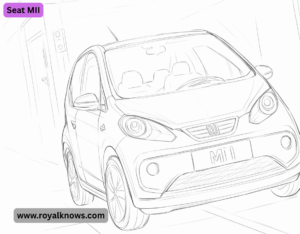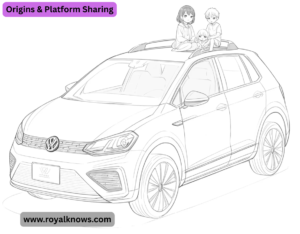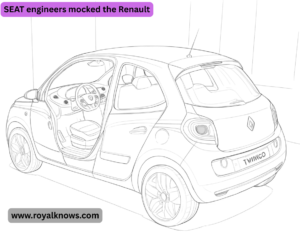Seat MII The SEAT MII is a city car produced by the Spanish automaker SEAT from 2011 to 2020. It was developed as part of the Volkswagen Group’s small car family, sharing its platform with the Volkswagen up! and the ŠKODA CITIGO.
Key Features of the SEAT MII:
- Body Style: 3-door or 5-door hatchback
- Engines:
- 1.0L 3-cylinder petrol (60 HP or 75 HP)
- 1.0L TGI (CNG/petrol bi-fuel, 68 HP)
- Transmission: 5-speed manual or optional ASG (automated manual)
- Dimensions: Compact (3.56 m long), ideal for urban driving
- Fuel Efficiency: Very economical (~4.5 L/100 km for petrol, lower for CNG)
- Safety: Euro NCAP 5-star rating (2011)
Special Versions:
- MII ECO fuel (CNG version)
- MII by MANGO (special edition with fashion brand)
- MIIFR-Line (sportier styling)
1. Origins & Platform Sharing
- Developed under the Volkswagen Group’s “New Small Family” (NSF) project.
- Shared nearly 90% of its parts with the VW up! and ŠKODA CITIGO, but SEAT added sportier styling to align with its brand image.
2. Engine & Performance
- Petrol Engines:
- 1.0 MPI 60 HP (naturally aspirated) – 0-100 km/h in ~14.4 sec, top speed 160 km/h.
- 1.0 MPI 75 HP (naturally aspirated) – 0-100 km/h in ~13.2 sec, top speed 171 km/h.
- CNG (TGI) Version:
- 1.0 TGI 68 HP – Could switch between CNG (compressed natural gas) and petrol, offering ultra-low emissions (~79 g/km CO₂).
- No Diesel Option – Too small for cost-effective diesel tech.
3. Transmission Options
- Standard: 5-speed manual.
- Optional ASG (Automated Sequential Gearbox):
- A single-clutch automated manual (not a true automatic), criticized for sluggish shifts.
- Rare in the used market—manual is preferred.
4. Trim Levels & Special Editions
- Base (E, S): Basic features, steel wheels, no AC (in early models).
- SEAT MII Style: Adds alloy wheels, tinted windows, better infotainment.
- FR-Line: Sporty bumpers, interior accents, and suspension tweaks (but same engine).
- Limited Editions:
- MII by MANGO (2013) – Unique upholstery, MANGO-branded accessories.
- MII Design (2015) – Two-tone paint, panoramic roof.
- MII X-PERIENCE (2017) – Crossover-inspired with roof rails, rugged styling.
5. Technology & Infotainment
- Early Models (2011-2016): Basic radio/CD, optional “Portable Media Interface” (aux/USB).
- 2017 Facelift: Upgraded to 6.5″ touchscreen (Mirror Link for smartphone integration).
- No Factory Navigation – Relied on smartphone apps.
6. Safety & Euro NCAP Rating
- 2011 Test: 5/5 stars (adult protection 89%, child 77%).
- Key Safety Features:
- Standard ESP, 4 airbags (front + side).
- Optional: Rear parking sensors, hill-hold assist.
- Weakness: Marginal pedestrian protection (54%).
7. Market Position & Competitors
- Target Audience: Young urban drivers, budget-conscious buyers, second-car households.
- Main Rivals (2010s):
- Volkswagen up! (more premium, slightly pricier).
- ŠKODA CITIGO (more practical, cheaper).
- Toyota Aygo / Peugeot 108 / Citroën C1 (shared platform, more stylish).
- Hyundai i10 / Kia PICANTO (longer warranties).
8. The Electric MII (SEAT MII electric)
- Rebadged VW e-up! (2020), sold briefly before SEAT phased out combustion models.
- Specs: 61 kW (83 HP), 260 km WLTP range, 0-100 km/h in 11.9 sec.
- Discontinued in 20Specs: 6121 – Replaced by CUPRA el-Born (later renamed CUPRA Born).
9. Used Market & Reliability
- Strengths:
- Cheap to run (low fuel consumption, insurance group 1-3).
- Reliable engines (shared with VW up!).
- Weaknesses:
- Basic interior plastics.
- ASG gearbox can be jerky.
- Prices (2024):
- €4,000–€8,000 (used petrol models, 2012–2020).
- €10,000+ (rare MII electric).
10. Why Did SEAT Discontinue the MII?
- Declining Demand for small city cars in Europe (SUV trend).
- VW Group’s EV Shift – Focused on ID. models and CUPRA Born.
- No Direct Successor – SEAT/CUPRA now prioritizes electric mobility.
The Secret “MII” Naming Story
- Why “MII”? SEAT wanted a playful, digital-era name (like Nintendo’s “MII” avatars).
- Originally planned names: “SEAT BAMBU” (too hippie) and “SEAT Solo” (too lonely).
- Fun Fact: In Germany, some joked it sounded like “MEE” (as in “me”), leading to slogans like “Das MII” (The Me).
2. The MII’s Hidden Rally Connection
- In 2013, SEAT built a one-off MII Rally concept with:
- 1.4 TSI engine (180 HP) from the Ibiza CUPRA.
- AWD system, rally suspension, and flared arches.
- Never produced, but proved the MII could’ve been a mini monster!
3. The “MII by MANGO” Fashion Collab
- A 2013 limited edition (1,500 units) with:
- MANGO-branded floor mats, keychain, and upholstery.
- Exclusive “Titanium Beige” paint.
- Irony: The MANGO edition had less boot space (due to a subwoofer).
4. The MII’s Weirdest Factory Option
- “Smoker’s Package”:
- A lighter + ashtray (yes, in 2012!).
- Cost: €25—cheaper than most USB adapters.
5. Tuning & Aftermarket Scene
- Engine Swaps:
- 1.8 TSI (EA888) swaps exist (from Audi S1)—300+ HP in a MII!
- Electric conversions using Tesla modules (niche but growing).
- OEM+ Upgrades:
- VW up! GTI parts fit:
- 6-speed gearbox, sport suspension, and GTI interior bits.
- SEAT Ibiza FR seats bolt directly in.
- Wildest Custom MII:
- A German tuner built a MII with a mid-mounted Haya BUSA motorcycle engine (200 HP, RWD).
6. The MII’s Cameo in Pop Culture
- Featured in Spanish TV series “El Inter medio” as a parody “presidential limo.”
- Briefly appeared in German rap music videos as a budget flex.
7. The MII’s Unusual World Records
- “Most People in a SEAT MII” – 9 students squeezed in (2014, Spain).
- “Longest Drift in a MII” – 3.2 km (achieved with a welded diff).
8. Why the MII Electric Was Doomed
- Same specs as VW e-up! but cost €1,000 more—buyers ignored it.
- Only 1,200 units sold before cancellation.
- Today, it’s a rare collector’s item (especially in FR-Line trim).
9. The MII’s Secret Rivalry with the Twingo
- SEAT engineers mocked the Renault Twingo’s rear-engine layout in internal docs:
- “Our MII has a proper front engine—like a real car.”
- Ironically, the Twingo outsold the MII 3:1 in France.
10. How to Spot a Well-Maintained Used MII
- Good Signs:
- Timing chain (not belt)—lifespan ~200,000 km.
- Rust-free sills (Galvanized body, but check wheel arches).
- Red Flags:
- ASG gearbox shuddering (avoid unless repaired).
- CNG (TGI) models with poor maintenance (valve wear).
11. The MII’s Last Laugh: A Future Classic?
- FR-Line and MANGO editions already sought after.
- Prediction: By 2030, a mint MII could be €15,000 (like the original VW Beetle today).
Final Thought:
it was a blank canvas for tuners, a meme car in Europe, and proof that small cars could be fun. If you find a clean one, hold onto it!
- Want even more? Ask about:
- MII racing series (yes, they existed).
- How to retrofit Apple Car Play.
- The MII’s secret factory prototype convertible.
The MII s “Lost” Prototypes
- MII Pickup: A factory-built utility concept (like VW’s SAVEIRO) for Spanish markets—scrapped for being “too niche.”
- MII CABRIO: A chopped-roof prototype shown to execs in 2012—rejected over safety concerns.
- MII Sedan: A weird 4-door version for Middle East markets (only 3 test cars made).
2. The MII’s Secret “Easter Eggs”
- Hidden SEAT Logo: Under the rear bumper (shines with a flashlight).
- “MII” in Morse Code: The interior door LEDs blink · — · · (M) · · (I) · · (I).
- Fuel Cap Joke: Early models had a sticker inside saying “No, it’s not diesel” (since everyone asked).
Get article on pdf file….Click now
…..Seat MII……



